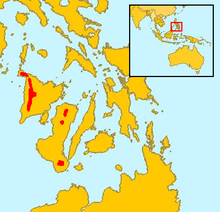Visayas pustular pig
| Visayas pustular pig | ||||||||||||
|---|---|---|---|---|---|---|---|---|---|---|---|---|

Visayas pustular pig ( Sus cebifrons ) |
||||||||||||
| Systematics | ||||||||||||
|
||||||||||||
| Scientific name | ||||||||||||
| Sus cebifrons | ||||||||||||
| Heude , 1888 |
The Visayas pustular pig ( Sus cebifrons ) is a species of mammal from the family of real pigs (Suidae) endemic to the Philippines . It is threatened with extinction . Names used locally in the Visayas for the Visayan pustular pig are Baboy Ihalas , Manggalisak Banban , Baboy Talunon , Bakatin .
features
Visayas pustular pigs reach a head body length of 80 to 100 centimeters, a shoulder height of around 60 centimeters and a weight of 30 to 70 kilograms. Their fur is dark brown in color, and the males are also characterized by a mane on the nape of the neck that continues along the back. As with all pustular pigs , their face has three pairs of pustular swellings.
distribution and habitat
These pigs are native to the Visayas , a group of islands in the Philippines . Today they still live in the Central Panay Mountains on the island of Panay and the areas around the volcanoes Mandalagan , Cuernos de Negros and Silay are limited to Negros , they are extinct on the island of Cebu and some smaller islands. Their habitat are forests, predominantly rainforests.
Way of life
Little is known about the way of life of the Visayas pustule pigs. They reportedly live in family groups of four to five animals, and solitary males are sometimes seen. Like most pigs, they are omnivores, feeding on fruits, roots, insects, eggs, small vertebrates, and carrion.
Visayas pustules and humans
Like many other mammals in the Philippines, the Visayan pustular pig is critically endangered. The reasons for this lie on the one hand in the ongoing destruction of their habitat, on the other hand in hunting - the animals are persecuted because they devastate plantations. Today there are still remnants in the west of Panay and in the protected areas of Northern Negros Natural Park , Mount Kanlaon Natural Park and Balinsasayao Twin Lakes Natural Park on Negros, and small breeding programs are also running. However, the survival of the species is questionable, the IUCN lists it as critically endangered .
literature
- DE Wilson & DM Reeder: Mammal Species of the World . Johns Hopkins University Press, 2005. ISBN 0-8018-8221-4
Web links
- Sus cebifrons in the endangered Red List species the IUCN 2006. Posted by: Pigs & peccaries Specialist Group, 1996. Accessed November 12 of 2006.
- Colin Groves: Taxonomy of wild pigs ( Sus ) of the Philippines. Zoological Journal of the Linnean Society 120: 163-191. (PDF file; 2.03 MB)
